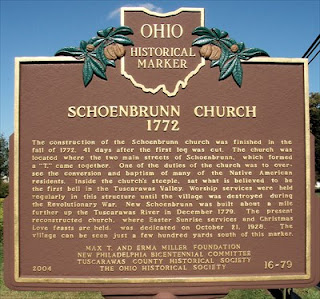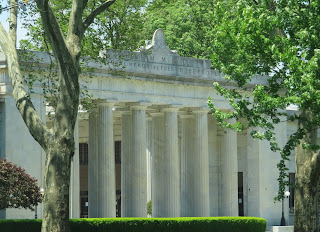We enjoyed a pancake breakfast, courtesy of the Band
Boosters and a church service in Hunter Hall (focusing on Numbers 22:31 – Open My Eyes Lord). After the service, the state staff had more door prizes to hand out. We won a hanging plant and Charlie gave it to Jan Tedrow, before I could kill it.
We departed the Coshocton Fairgrounds on Route 36E. We
traveled this route several times on our tours at the Ohio Good Sam’s Rally. We
passed these oil tanks, but never noticed the saying stenciled on them.
“American Soil. American Oil.” That basically says it all!
I love these metal city signs that many towns in Ohio
have. It gives you a little glimpse into the history of the town or a famous
person. Can you believe that in 1836, there was someone that was considered a
landscape artist? I would have associated that with more modern times. Oh wait,
are they saying he painted landscapes? Got it now ….
Port Washington was a bustling city and major port on
the Ohio-Erie Canal - until 1852 and the arrival of the railroad in Millersburg
and Baltic. Use of Port Washington Road waned even more after a flood destroyed
the canal's usefulness in 1913. The road was designated as "Road Number
20" by the State of Ohio on February 6, 1832 making it the first official
state road.
In the 1800’s and early 1900’s the Ohio & Erie
Canal which ran from Lake Erie at Cleveland to the Ohio River in Portsmouth,
played a vital role in meeting the shipping and transportation needs of early
Ohioans. At the time, the Village of Tuscarawas was known as “Trenton” and lock
15 & 16 acted as important loading and shipping points to the commerce opportunities
located throughout the rest of Ohio. Residents named the county and town after
a Native American word meaning “open mouth” referring to the rivers in the area.
Among the first white residents of the county were
Moravian missionaries, who sought to convert members of the Delaware natives.
The missionaries established the villages of Schoenbrunn and Gnadenhutten to
carry out their work. Schoenbrunn Village is the site of several Ohio
firsts—settlement, church, schoolhouse and code of laws. It was founded in 1772
as a Moravian mission among the Delaware Indians, was the first Christian
settlement in Ohio.
The village was established by David Zeisberger, who
in 1772 found a rare pocket of neutrality in a region that was tense as the
American Revolution approached. Five Indian families and Zeisberger came to the
Tuscarawas River area to find a suitable site for a mission, upon an invitation
of the Delaware Indian leader Netawatwes to establish a mission in the Ohio
country. The village established the state’s first civil code and built the
first schoolhouse. Toward the end of its short, five-year history, the
villagers were harassed from both sides: the American Indians, who were under
the influence of the British, and the American frontiersmen, who were pushing
their way farther into the Ohio country. By 1777, pressured by the opposing
forces, the villagers chose to abandon Schoenbrunn. Upon leaving, they ruined
the meetinghouse so it could not be used again.
New Philadelphia Ohio is most famous of the
Schoebbrunn Settlement, but there is a Victorian style house in town that is
trying to make its mark. I have never seen so many different styles and types
of statues in one yard that were not for sale! The color of the turret in both
pictures is unique too!
I found an old picture, on Pintrest, and the previous
owners had several statues and fountains too, but they were more Grecian in
style.
We transitioned onto Ohio Route 39 E then
onto 9 N. In Carrollton Ohio, we passed by the Carroll County Arts Center building
and the fence instantly attracted my attention.
Each fence slat is a different
member of the community, unique and different. Some are people, some are
animals and some represent a cause. I think this fence embodies their
philosophy, “Art for Everyone.” What do you think?
Just on the edge of downtown Carrollton, we pulled
over to let about 100 motorcycles pass. There must have been a poker run
somewhere. The coolest thing about pulling over and letting them pass, was an
old car was traveling in the opposite direction. As, it passed there was a
motorcycle almost the same color … the old and the modern … together.
In Augusta Ohio, we were still traveling on OH Route
9 and we came across another piece of “Mail Pouch” advertising. In an earlier
blog, this month I talked about another Mail Pouch Barn advertisement, we had
seen in Ohio. However, this is the first time I have seen it advertised on a
building. But, in doing my research, I see that they did advertise that way
too.
In Hanoverton Ohio, we turned onto the Lincoln Highway.
The marker here was for the Mansion House Hotel. The building was erected here
in 1844 and burned down in 1918. The Lincoln Highway in Ohio combines history
that predates Ohio's statehood with how America changed and grew with the
advent of automobile travel from 1913 onward. Many of the original signs,
monuments, and painted telephone poles that initially marked the route can
still be seen today. During the 1840s, Hanoverton once hosted the Sandy and
Beaver Canal with barges of goods towed at mule speed. Hanoverton also has a
breathtaking, 1840s' housing development much like those in Georgetown or
Williamsburg. The towns along the route exemplify Lincoln Highway's best-known
slogan, "Main Street Across America," with their tree-lined streets,
magnificent courthouse, and historic business district. We have traveled on the Lincoln Highway before, just not in Ohio.
Coxswain Robert B Wood was a Civil War Congressional
Medal of Honor Recipient. He served as a Coxswain in the Union Navy. His
citation reads "Attached to the USS Minnesota and temporarily served on
the USS Mount Washington during action against the enemy in the Nansemond
River, 14 April 1863. When the USS Mount Washington drifted against the bank
and all men were driven from the decks by escaping steam following several successive
hits which struck her boiler and stopped her engines, Wood boarded the stricken
vessel and, despite a strike on the head by a spent ball, continued at his gun
for six hours as fierce artillery and musketry continued to rake her
decks." He was reinterred from Columbus State Hospital Cemetery, Columbus,
Ohio in June 1998 to the Grove Hill Cemetery, Hanoverton, Ohio.
Coming into Niles Ohio, the first thing you notice is
the bright orange sign, you certainly can’t miss it!
The second thing you notice is the 20-foot-tall sculpture
titled “The Steelworker.” He has stood at the entrance to Niles Iron and Metal
Company’s scrapyard on state Route 46 in Niles. The sculptor, Sidney Rackoff,
was 74 years old when he created the sculpture. It took him over a six-month
period at the scrap-metal company’s maintenance shop, finishing it in 1993. Like
much of his work, Rackoff made the piece out of scrap he found at the business.
He was a steel worker at Youngstown Sheet & Tube when he was in his 20s. At
about age 50, he was ordained a rabbi and served in several cities until he was
83. He took up art at age 60 and created more than 70 major pieces of art, some
of which are permanently displayed at buildings in the region.
The third thing you notice is the National McKinley
Birthplace Memorial. On March 4, 1911, President William Howard Taft,
authorized Congressional funding for a national memorial to be located in the
town of McKinley's birth: Niles, Ohio. The same act of Congress had also officially
established the National McKinley Birthplace Association. Association President
Joseph G. Butler, Jr., who had been a childhood friend and schoolmate of
McKinley, began a $100,000 local campaign to raise funds for the Memorial in
1912. The cornerstone of the Memorial was laid on November 20, 1915, and an
inscribed plaque on it read "Erected 1915. To Perpetuate the Name and
Achievements of William McKinley, Twenty-fifth President of the United States
of America. Born January 29, 1843. Died September 14, 1901." The United
States Marine Band played "On the Beautiful Blue Danube" (a favorite
of Mrs. McKinley's) and "Lead Kindly Light" (reportedly a hymn sung
at McKinley's deathbed) after a parade of organizations to which McKinley
belonged proceeded down Niles' Main Street.
President William McKinley had been dead for over 16
years when this memorial and museum opened on October 5, 1917. The temple-like
memorial features an open colonnade with a 12-foot-tall, 35-ton marble statue
of McKinley by sculptor J. Massey Rind. It's surrounded by a "Court of
Honor" of bronze busts of other powerful men of 1917, including former
Presidents Teddy Roosevelt and William Howard Taft, and future President Warren
Harding.
As we drove through Cortland Ohio, we were lucky
enough to see a ceremony being conducted at the Veterans Memorial. We learned
that past and current servicemen and servicewomen were honored during the
Cortland Veterans Memorial Committee's 2019 Armed Forces-Memorial Day Service today.
Base Commander Col. Joe Janik of the 910th Airlift Wing was the event's guest
speaker. Organizers picked Sunday for the ceremony since it fell between the
two holidays.
They can honor both those currently serving and those
who have served, and who have lost their lives and those who came home safely.
They decided to just to celebrate out of our gratitude to all the veterans that
have served. The event was the first Memorial Day observance at the new
memorial on South High Street. The committee raised $180,000 through donations
to build it.
We continued on OH Route 5, then turned north onto OH
Route 193. We took a right onto US 322 E and entered the last town in Ohio,
before we enter Pennsylvania. Here we saw a homemade Ohio bicentennial barn. It
has some of the same characteristics as the Ohio Bicentennial Barns.
We crossed the Ohio Pennsylvania State Line and
quickly arrived at Pymatuning State Park and the Jamestown Campground. This
will be our home for three nights.
























No comments:
Post a Comment